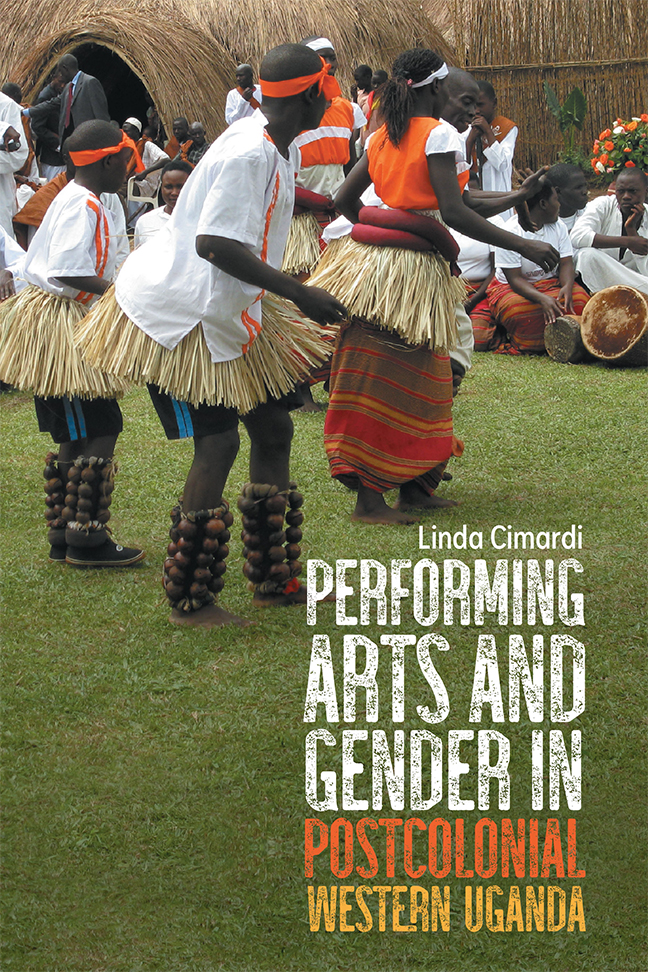Book contents
- Frontmatter
- Contents
- List of Illustrations
- Foreword
- Acknowledgments
- Note on Language
- Note on the Musical Examples
- Note on Online Audio and Video Material
- Prelude: Encountering Local Culture in Western Uganda
- Introduction: Approaching Gender and Performing Arts in Bunyoro and Tooro
- One “Traditional Dance Preserves Culture and Shows People How to Behave”: Runyege, MDD, and Gender
- Two Singing Marriage, Runyege, and Labor
- Three “Women Aren't Supposed To”: Instrument Playing in the Past and Today
- Four Shaking the Hips, Stamping the Feet: The Runyege Dance
- Five Narrating and Representing Local Culture: Theater in Songs and Dances
- Six Trans-Performing and Morality in Cultural Groups
- Postlude: Gendering Culture
- I Glossary of Terms in Runyoro-Rutooro
- II Historical Recordings from Bunyoro and Tooro
- Author's Interviews
- References
- Index
Five - Narrating and Representing Local Culture: Theater in Songs and Dances
Published online by Cambridge University Press: 17 December 2023
- Frontmatter
- Contents
- List of Illustrations
- Foreword
- Acknowledgments
- Note on Language
- Note on the Musical Examples
- Note on Online Audio and Video Material
- Prelude: Encountering Local Culture in Western Uganda
- Introduction: Approaching Gender and Performing Arts in Bunyoro and Tooro
- One “Traditional Dance Preserves Culture and Shows People How to Behave”: Runyege, MDD, and Gender
- Two Singing Marriage, Runyege, and Labor
- Three “Women Aren't Supposed To”: Instrument Playing in the Past and Today
- Four Shaking the Hips, Stamping the Feet: The Runyege Dance
- Five Narrating and Representing Local Culture: Theater in Songs and Dances
- Six Trans-Performing and Morality in Cultural Groups
- Postlude: Gendering Culture
- I Glossary of Terms in Runyoro-Rutooro
- II Historical Recordings from Bunyoro and Tooro
- Author's Interviews
- References
- Index
Summary
Regarding the runyege troupe actors who act a love-story whose words are sung by musicians to a drum rhythm, it may be concluded that a conscious development from song to drama is emerging.
—Mukasa-Balikuddembe (1973: 382)In his master's thesis, the late Nyoro theater scholar Joseph Mukasa- Balikuddembe (1973) thus summarized his findings on runyege, which emerged from his investigation of the “indigenous elements of theater” in Bunyoro and Tooro. Examining the ceremonies connected to the life cycle, royalty, traditional religion, and local forms of entertainment, Mukasa- Balikuddembe (1973: 368) considered local theatrical expressions as marked by the participation of the audience and a type of theatrical communication that he defined as “unpretentious,” in opposition to the mostly elitist Western drama forms. Focusing on a runyege performance where the song is about love and courtship, he showed the strict relationship between the song's lyrics and danced action and highlighted its theatrical dimension. Furthermore, he emphasized the connection between acting and telling a story, two fundamental elements of theater that can be found in contemporary performances of traditional genres like runyege.
In this chapter, I focus on the drama component of MDD (music, dance, and drama), understood not as theater pieces, but rather in Mukasa-Balikuddembe's sense of theatrical strategies and practices. In particular, I discuss the paradigms of narration, as the causal development of consequent actions similar to a story, and representation, as including acting, costumes, and makeup. I connect these theatrical devices as found in the traditional practice of singing, instrument playing, and dancing to their contemporary use within the national school festival. In my analysis, the theatrical practices of narrating, costuming, and acting emerge as essential dimensions of performing gender in today's Ugandan traditional repertoires, as it happens in other traditional music and dance contexts, such as in East Java (Sunardi 2015). By exploring the interconnectedness of dramatic strategies and elements with other performing arts, I seek not only to highlight the complexity of runyege as a genre, but also to suggest how, along with defined and hegemonic structures and meanings, which I analyze here, there are also possibilities of alternate interpretations that show the flexibility of the genre, as I examine in more detail in chapter 6.
- Type
- Chapter
- Information
- Performing Arts and Gender in Postcolonial Western Uganda , pp. 164 - 189Publisher: Boydell & BrewerPrint publication year: 2023



